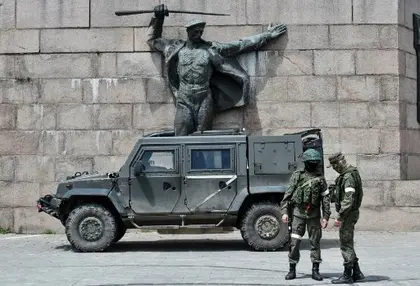Top Moscow generals on Wednesday, Nov. 9, 2022, announced all Russian Federation (RF) troops would abandon the key port city of Kherson and the entire right bank of the Dnipro River, marking one of the worst setbacks yet in Russian President Vladimir Putin’s shambolic, eight-month attempt to annex Ukrainian territory and destroy Kyiv’s military.
RF Defense Minister Sergei Shoigu, in a set-piece televised meeting with top staff, said he “accepted” their suggestion that RF forces evacuate a bridgehead in and around the city, and pull back all forces to prepared defensive positions in the south.
- Access the latest Ukraine news coverage for today.
- Look at the latest Ukraine news that was released today.
JOIN US ON TELEGRAM
Follow our coverage of the war on the @Kyivpost_official.
The RF military’s ability to supply ground units in the Kherson perimeter had become increasingly shaky following continuous Armed Forces of Ukraine (AFU) bombardments – using mostly U.S.-manufactured, precision-guided munitions – of three key bridges and one hydroelectric dam linking the bridgehead on the north bank of the river with RF army depots and reserves on the south.
RF engineers are unable to repair the bridges as quickly as the AFU rockets and missiles inflict more damage, and Ukrainian strikes will inevitably sink or render immobile the few ferries still linking RF troops with safety, said area commander Lieutenant General Sergey Surovikin in a report to Shoigu.
“Under the present circumstances, the city of Kherson and localities near it cannot be properly supplied, nor can they properly function,” Surovikin said.

Diane Francis Interviews Mikhail Zygar, Yaroslav Trofimov on Prospects of Russia’s War on Ukraine
Shoigu said the retreat should be made at a measured pace and that any civilians wishing to evacuate the region ahead of AFU troops “should be given the opportunity to leave.”
Kherson was the only regional capital captured by Russia in the Kremlin’s eight-month war with Ukraine. The Kremlin, with great fanfare on Sept. 30, announced Russia had annexed the Kherson region and that the some half-million residents still living there had become Russian citizens, and that Russian state presence would be “eternal.”
Kirill Stremousov, the Kremlin-appointed head of the Kherson occupation authority, and in recent weeks one of the most adamant supporters of the narrative that Russia would “never leave Kherson,” died in an automobile accident on Wednesday, RF state-controlled media reported.
Russian President Vladimir Putin made no immediate statements following Shoigu’s and Surovikin’s remarks. As in the Kremlin’s previous two major defeats – the evacuation of the Kyiv and Chernihiv regions in March, and the AFU’s conquest of most of the Kharkiv region in September – the Russian leader seemed to be keeping a low profile, with no public appearances reported in Russian state media.
Mykhailo Podolyak, a close advisor to President Volodymyr Zelensky, in one of the first official Kyiv reactions to the Kremlin announcement said that the AFU would not change its tactics in the southern sector: They would reconnoiter, then evaluate risk, and only then counterattack.
“As long as the Ukrainian flag is not waving over Kherson, there is no sense in commenting on Russia’s retreat,” Podolyak said in comments to the Reuters news agency, and reported by most major Ukrainian news programs.
Reports of the planned Russian retreat came on the heels of a wave of social media messages, some purportedly written by AFU troops involved in the fighting, attesting to a serious deterioration of RF defensive positions around the town Snihurivka, to the east of Kherson.
According to these unconfirmed Telegram reports, Ukrainian troops had at least partially broken through RF defensive lines, and threatened a breakthrough to the sole remaining land crossing of the Dnipro River in the area, a hydroelectric dam near the town Nova Kakhovka.
Both Ukrainian and RF-associate information platforms reported RF army units had blown up seven bridges within the Kherson defensive ring in an attempt to slow down advancing AFU units.
You can also highlight the text and press Ctrl + Enter






